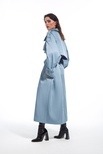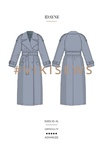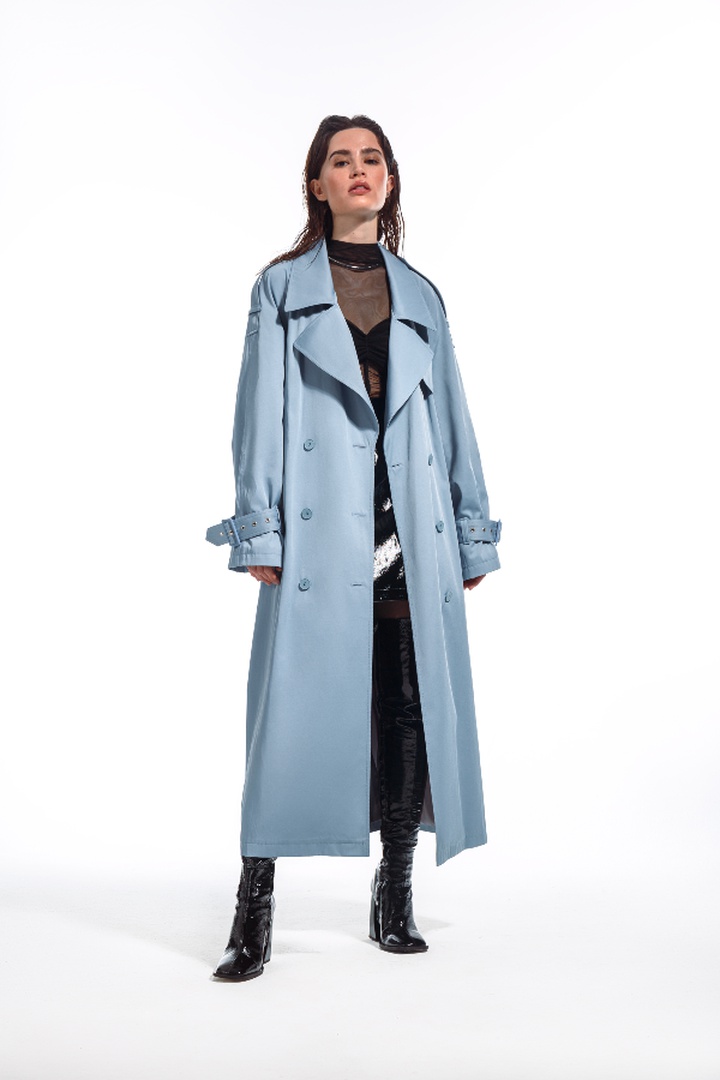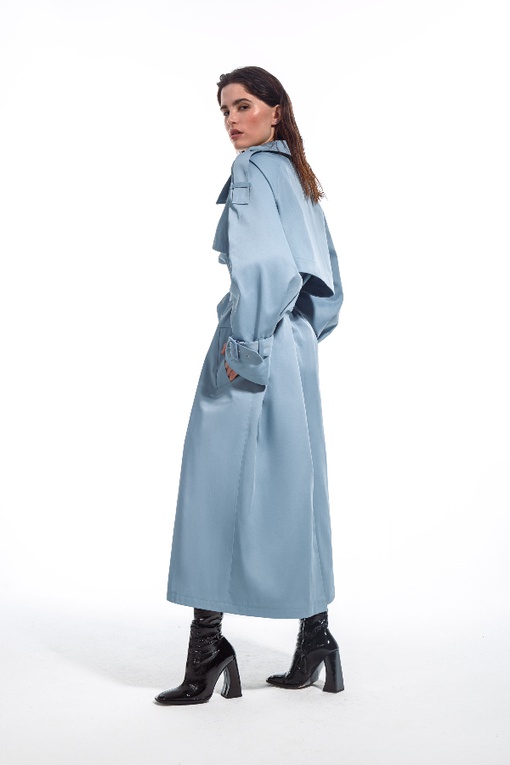Idayne trench coat sewing course
Sizes: 34–52 (EU) Size chart
The access to the video lessons is not limited in time.
Size | Bust ease, cm | Waistline ease, cm | Hipline ease, cm | Upper arm ease, cm |
XS–S | 43–51 | 63–71.1 | 37.2–45.2 | 32.1–36.2 |
M–L | 39–51 | 59–71.1 | 33.2–45.3 | 27.8–34.5 |
XL | 39–47 | 59.1–67.1 | 33.2–41.2 | 25–30.8 |
Size | Bust ease, in | Waistline ease, in | Hipline ease, in | Upper arm ease, in |
XS–S | 16 7/8–20 1/8 | 24 3/4–28 | 14 5/8–17 3/4 | 12 5/8–14 1/4 |
M–L | 15 3/8–20 1/8 | 23 1/4–28 | 13 1/8–17 7/8 | 11–13 5/8 |
XL | 15 3/8–18 1/2 | 23 1/4–26 3/8 | 13 1/8–16 1/4 | 9 7/8–12 1/8 |
Height, cm | Back length, cm | Sleeve length including shoulder width, cm |
1 (154–160) | 120–121.2 | 73.9–74.8 |
2 (162–168) | 125–126.2 | 75.6–76.7 |
3 (170–176) | 130–131.2 | 77.9–78.8 |
4 (178–184) | 135–136.2 | 80.2–80.8 |
Height, ft | Back length, in | Sleeve length including shoulder width, in |
1 (5’1”–5’3”) | 47 1/4–47 3/4 | 29 1/8–29 1/2 |
2 (5’4”–5’6”) | 49 1/4–49 5/8 | 29 3/4–30 1/4 |
3 (5’7”–5’9”) | 51 1/8–51 5/8 | 30 5/8–31 |
4 (5’10”–6’1”) | 53 1/8–53 5/8 | 31 5/8–31 3/4 |
1.1. Main fabric, 140 cm wide, with a directional print/nap, cut on fold, in meters:
Height, cm | XS–S | M–L | XL |
1 (154–160) | 4 | 4.2 | 4.45 |
2 (162–168) | 4.1 | 4.25 | 4.6 |
3 (170–176) | 4.2 | 4.35 | 4.75 |
4 (178–184) | 4.3 | 4.4 | 4.9 |
Main fabric, 55" wide, with a directional print/nap, cut on fold, in yards:
Height, ft | XS–S | M–L | XL |
1 (5’1”–5’3”) | 4 3/8 | 4 5/8 | 4 7/8 |
2 (5’4”–5’6”) | 4 1/2 | 4 5/8 | 5 |
3 (5’7”–5’9”) | 4 5/8 | 4 3/4 | 5 1/4 |
4 (5’10”–6’1”) | 4 3/4 | 4 3/4 | 5 3/8 |
1.2. Main fabric, 150 cm wide, with a directional print/nap, cut on fold, in meters:
Height, cm | XS–S | M–L | XL |
1 (154–160) | 3.7 | 3.85 | 4.1 |
2 (162–168) | 3.7 | 3.9 | 4.2 |
3 (170–176) | 3.8 | 4.05 | 4.45 |
4 (178–184) | 3.85 | 4.15 | 4.55 |
Main fabric, 59" wide, with a directional print/nap, cut on fold, in yards:
Height, ft | XS–S | M–L | XL |
1 (5’1”–5’3”) | 4 | 4 1/4 | 4 1/2 |
2 (5’4”–5’6”) | 4 | 4 1/4 | 4 5/8 |
3 (5’7”–5’9”) | 4 1/8 | 4 3/8 | 4 7/8 |
4 (5’10”–6’1”) | 4 1/4 | 4 1/2 | 5 |
2. Lining fabric, 140 cm wide, with a directional print, cut on fold, in meters:
Height, cm | XS–S | M–L | XL |
1 (154–160) | 1.95 | 2.4 | 2.65 |
2 (162–168) | 2 | 2.5 | 2.75 |
3 (170–176) | 2.1 | 2.6 | 2.85 |
4 (178–184) | 2.15 | 2.7 | 2.95 |
Lining fabric, 55" wide, with a directional print, cut on fold, in yards:
Height, ft | XS–S | M–L | XL |
1 (5’1”–5’3”) | 2 1/8 | 2 5/8 | 2 7/8 |
2 (5’4”–5’6”) | 2 1/8 | 2 3/4 | 3 |
3 (5’7”–5’9”) | 2 1/4 | 2 7/8 | 3 1/8 |
4 (5’10”–6’1”) | 2 3/8 | 3 | 3 1/4 |
IMPORTANT! When purchasing the main and lining fabrics, please account for shrinkage and buy 5% more than required.
3. Interfacing, 50 g/m2, 140 cm wide, cut on fold in one direction, in meters:
Height, cm | XS–S | M–L | XL |
1 (154–160) | 1.45 | 1.55 | 1.7 |
2 (162–168) | 1.45 | 1.55 | 1.7 |
3 (170–176) | 1.45 | 1.55 | 1.7 |
4 (178–184) | 1.45 | 1.55 | 1.7 |
Interfacing, 50 g/m2, 55" wide, cut on fold in one direction, in yards:
Height, ft | XS–S | M–L | XL |
1 (5’1”–5’3”) | 1 5/8 | 1 3/4 | 1 7/8 |
2 (5’4”–5’6”) | 1 5/8 | 1 3/4 | 1 7/8 |
3 (5’7”–5’9”) | 1 5/8 | 1 3/4 | 1 7/8 |
4 (5’10”–6’1”) | 1 5/8 | 1 3/4 | 1 7/8 |
4. Lightweight interfacing, 30 g/m2 (for interfacing the pocket area), for all sizes in all heights — 25 cm (9 7/8")
5. All-purpose matching thread for the main fabric — 2 spools
6. All-purpose matching thread for the lining fabric — 1 spool
7. Topstitching thread — 1–2 spools depending on the thread length (two 30 m or 33 yd spools). You may use a single or double all-purpose thread matching the main fabric for topstitching
8. Straight-grain fusible stay tape, 1–1.5 cm (3/8–5/8") wide — about 6 m (6 1/2 yd)
9. Bias-cut fusible stay tape, 1–1.5 cm (3/8–5/8") wide — about 3 m (3 1/4 yd)
10. Buttons:
- eleven buttons, 2.2–2.5 cm (7/8–1”) in diameter
- seven backing buttons, 1 cm (3/8") in diameter
11. One 5 cm (2") wide (inner width) prong buckle for the belt
12. Two 4.5 cm (1 3/4") wide (inner width) prong buckle for the sleeve tabs
13. 20 grommets, 5 mm (just under 1/4") in diameter
14. Fabric for the toile such as unbleached calico (the requirement is the same as for the main fabric, plus appr. 0.5 m [1/2 yd] of the interfacing)














































Страница VK
VikiSews
Канал на YouTube
VikiSews
Telegram-канал
Vikisews Patterns